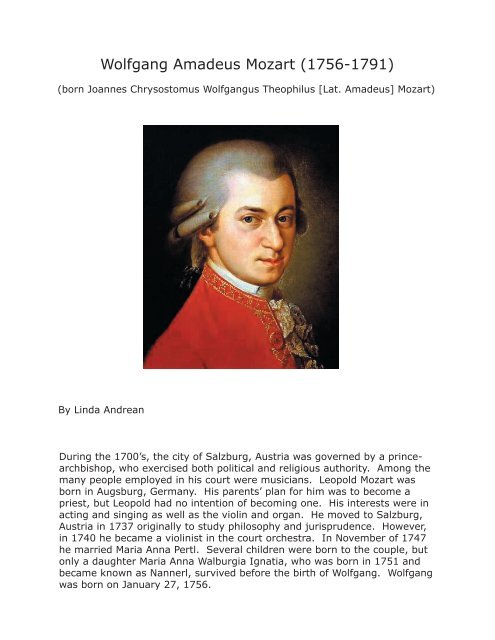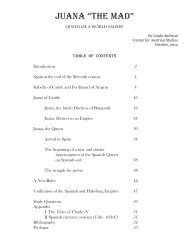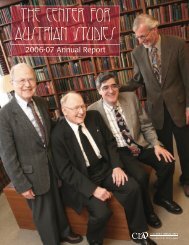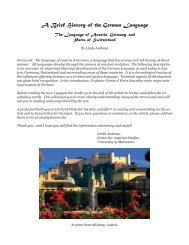Wolfgang Amadeus Mozart (1756-1791) - Center for Austrian Studies
Wolfgang Amadeus Mozart (1756-1791) - Center for Austrian Studies
Wolfgang Amadeus Mozart (1756-1791) - Center for Austrian Studies
Create successful ePaper yourself
Turn your PDF publications into a flip-book with our unique Google optimized e-Paper software.
<strong>Wolfgang</strong> <strong>Amadeus</strong> <strong>Mozart</strong> (<strong>1756</strong>-<strong>1791</strong>)<br />
(born Joannes Chrysostomus <strong>Wolfgang</strong>us Theophilus [Lat. <strong>Amadeus</strong>] <strong>Mozart</strong>)<br />
By Linda Andrean<br />
During the 1700’s, the city of Salzburg, Austria was governed by a princearchbishop,<br />
who exercised both political and religious authority. Among the<br />
many people employed in his court were musicians. Leopold <strong>Mozart</strong> was<br />
born in Augsburg, Germany. His parents’ plan <strong>for</strong> him was to become a<br />
priest, but Leopold had no intention of becoming one. His interests were in<br />
acting and singing as well as the violin and organ. He moved to Salzburg,<br />
Austria in 1737 originally to study philosophy and jurisprudence. However,<br />
in 1740 he became a violinist in the court orchestra. In November of 1747<br />
he married Maria Anna Pertl. Several children were born to the couple, but<br />
only a daughter Maria Anna Walburgia Ignatia, who was born in 1751 and<br />
became known as Nannerl, survived be<strong>for</strong>e the birth of <strong>Wolfgang</strong>. <strong>Wolfgang</strong><br />
was born on January 27, <strong>1756</strong>.
Leopold <strong>Mozart</strong> about 1765.<br />
Portrait attributed to Peitro Antonio Lorenzoni<br />
<strong>Wolfgang</strong> and Nannerl were extremely gifted musically as children. Nannerl<br />
began music lessons on the clavier (an early piano) at the age of seven.<br />
<strong>Wolfgang</strong>, aged three, would spend hours picking out tunes, so by the age<br />
of four, their father began teaching <strong>Wolfgang</strong> minuets. He learned them<br />
very easily and by the age of five, began composing his own music, which<br />
he would play to his father who then wrote the music down. <strong>Wolfgang</strong>’s first<br />
appearance as a child prodigy was playing the clavier at the age of five in an<br />
appearance with his sister be<strong>for</strong>e the court at Munich.<br />
Records of the early tours of the <strong>Mozart</strong> family are to be found in letters Leopold<br />
wrote to Lorenz Hagenauer, the family friend and landlord of the <strong>Mozart</strong><br />
home. Hagenauer was most likely the person who financed the early travels<br />
of the <strong>Mozart</strong> family. In September, 1762 the <strong>Mozart</strong> family set out <strong>for</strong> Vienna<br />
to per<strong>for</strong>m, and did not return home until January 1763. As young <strong>Wolfgang</strong><br />
was per<strong>for</strong>ming be<strong>for</strong>e the royalty of Europe, he was losing his baby<br />
teeth!<br />
In her reminiscences, Nannerl summed up the first part of their<br />
tour: “Munich, Augsburg, Ulm, Ludwigsburg, Bruchsal, Schwetzingen,<br />
Heidelberg, Mannheim, Worms, Mainz, Frankfurt on Main,<br />
Mainz, Coblenz, Bonn, Brühl, Cologne, Aix-la-Chapelle, Liège, Tillemonde,<br />
Louvain, Brussels, Mons, Paris, where they arrived on<br />
the 18th November 1763.”<br />
From http://www.mozartproject.org/biography/bi_61_65.html
<strong>Wolfgang</strong> probably painted by Pietro<br />
Antonio Lorenzoni, 1763.<br />
The beautiful outfi t was a gift from the<br />
Empress Maria Theresa<br />
<strong>Mozart</strong> as a child was greatly adored at the<br />
<strong>Austrian</strong> court of Empress Maria Teresa.<br />
1763 one of the fi rst major concert tours <strong>for</strong> <strong>Mozart</strong> to the courts of Europe.
Illustration by Elaine<br />
Bonabel in Mörike, p. 119<br />
depicting a typical trip by<br />
<strong>Mozart</strong>.<br />
The family most often rented<br />
a coach, but on occasion<br />
either purchased one or<br />
were lent a coach to use.<br />
The horses were rented <strong>for</strong><br />
use <strong>for</strong> a certain number<br />
of miles and would then be<br />
exchanged <strong>for</strong> fresh horses<br />
at the next Inn stop.<br />
The roads were rough and<br />
the springs in the coaches<br />
not very com<strong>for</strong>table <strong>for</strong><br />
long distance travel. Note<br />
the springs on the coach in<br />
the drawing.<br />
On Christmas Eve, 1763, the <strong>Mozart</strong>s were invited to the French court of Queen<br />
Maria Leszczynska and Louis XV <strong>for</strong> two weeks. On New Years Day the <strong>Mozart</strong><br />
family was invited to the court dinner with the royal couple. The family stood behind<br />
the royal couple during the meal. Leopold described the experience:<br />
“My <strong>Wolfgang</strong> was graciously privileged to stand beside the Queen the<br />
whole time, to talk constantly to her, entertain her and kiss her hands<br />
repeatedly, besides partaking of the dishes which she handed him from the<br />
table,” . . . “I stood beside him, and on the other side of the King . . . stood<br />
my wife and daughter.”<br />
(www.mozartproject.org/biography/bi_61_65.html)
For the next several years, family life consisted of traveling. The purpose of these<br />
trips was to show off the musical abilities of the two extraordinary children. During<br />
the trips to Paris, the most important musical center in Europe, then to England,<br />
Germany, and Italy young <strong>Wolfgang</strong> met many famous musicians and learned a<br />
great deal from them. He began to compose music seriously, so that by the time<br />
he was nine years old in 1765, his fi rst sonatas were being published in Paris.<br />
During these intense early travels <strong>Wolfgang</strong> also contracted several serious illnesses:<br />
strep throat, rheumatoid arthritis and typhoid fever, from which he nearly<br />
died.<br />
Between 1763 and 1765 during his travels, <strong>Wolfgang</strong> composed:<br />
2 sonatas while in Paris<br />
7 sonatas while in London as well as two symphonies,<br />
2 arias, a motet (a choral composition) and several<br />
untitled pieces<br />
and while in The Hague, an aria and a symphony.<br />
<strong>Mozart</strong> was defi nitely a unique child!<br />
Estimated distances<br />
between<br />
cities:<br />
Vienna to<br />
Amsterdam=<br />
938 km/538 mi.<br />
Paris=1,037 km<br />
/645 mi.<br />
London =1,237<br />
km/668 mi.
Leopold <strong>Mozart</strong> and his children<br />
L. C. de Carmontelle watercolor, 1763-64<br />
<strong>Wolfgang</strong> Hildesheimer describes the early works as composed<br />
“with an originality of melody and modulation which goes beyond<br />
the routine methods of this contemporaries.” (pp. 34-5) <strong>Mozart</strong> at<br />
this young age possessed the ability to vary the moods of the music<br />
within the conventional <strong>for</strong>ms of the period. <strong>Mozart</strong> later wrote to<br />
his father that music must not offend the ear but must please those<br />
listening.<br />
On the return to Salzburg in 1769, <strong>Wolfgang</strong> composed masses <strong>for</strong><br />
the cathedral of the prince-archbishop. An important tradition in<br />
Salzburg was the custom of the graduating students at the Benedictine<br />
University to celebrate the end of the academic year with a<br />
serenade called “Finalmusik”, which was composed <strong>for</strong> a march or<br />
procession of the students. The march would be commissioned by<br />
the students or their families in honor of the graduation. <strong>Wolfgang</strong><br />
composed several such marches.
By the end of 1769, father and son<br />
were off to Italy <strong>for</strong> new composing<br />
opportunities and exposure to new<br />
audiences. <strong>Wolfgang</strong> was now composing<br />
symphonies, sonatas, concertos,<br />
operas and arias. The life of the<br />
young <strong>Mozart</strong> was one of travel, composing<br />
and per<strong>for</strong>ming. Returning to<br />
Salzburg in 1772, <strong>Wolfgang</strong> received a<br />
<strong>for</strong>mal court position as the Konzertmeister,<br />
which meant he now received<br />
a salary. He was also busy composing<br />
<strong>for</strong> many private patrons, which<br />
was an important source of income<br />
<strong>for</strong> musicians and composers. The<br />
composer Franz Josef Haydn was an<br />
important influence on his work during<br />
this period, especially in writing<br />
string quartets. During this period,<br />
<strong>Wolfgang</strong> wrote his first true keyboard<br />
concerto (K.175 in D), which was<br />
among the few of his keyboard concertos<br />
to be published in his lifetime.<br />
While in Salzburg, he was busy composing<br />
sacred music.<br />
In 1774, <strong>Wolfgang</strong> was invited to compose an opera buffa (comic opera) <strong>for</strong> the<br />
Munich opera season. The opera was La finta giardiniera (the feigned garden-girl).<br />
Operas were written specifically <strong>for</strong> the singers who were to per<strong>for</strong>m them, which<br />
meant the composer had to work closely with the per<strong>for</strong>mers and understand the<br />
ability of each singer. During his stay in Munich, <strong>Wolfgang</strong> was also busy writing<br />
sonatas. The most popular sonata was K.283 in G because of its workmanship,<br />
sequence of ideas, phrase repetitions and ingenious tonal balance (Sadie, p. 369).<br />
With the sonatas, Stanley Sadie points out, <strong>Wolfgang</strong> developed from composing<br />
conventional music to works of much greater individuality. Returning to Salzburg<br />
in March 1775, <strong>Wolfgang</strong> turned to composing concertos along with serenades of<br />
the Finalmusik type. He was to continue working in Salzburg until 1777 in his position<br />
as Konzertmeister on an annual salary of 150 gulden.<br />
In August of 1777, <strong>Wolfgang</strong> received permission from the Salzburg prince-archbishop<br />
Colloredo to be released from his appointment. Leopold had to remain at<br />
court, so it was <strong>Wolfgang</strong>’s mother who traveled with him now to the courts of<br />
southern and western Germany seeking an appointment hopefully in Mannheim or<br />
Munich. As in the <strong>for</strong>mer travels, the <strong>Mozart</strong>s traveled by horse-drawn coaches,<br />
which they would have either bought or rented. Horses would be hired at various<br />
inns along the way. The route Leopold carefully planned <strong>for</strong> mother and son to
take would bring them in contact with friends along the way whom Leopold<br />
thought would be most helpful. This was <strong>Wolfgang</strong>’s first venture into the<br />
world without his father. Maria was following her husband’s instructions but<br />
did not make the same demands on <strong>Wolfgang</strong> as her husband would have.<br />
Thus <strong>for</strong> the first time in his life, <strong>Wolfgang</strong> had more of a role in the decisions<br />
of what he wanted to do. He had a new sense of independence. From the<br />
correspondence between the family members, it is clear Leopold did not appreciate<br />
his son’s decisions.<br />
<strong>Wolfgang</strong> and his mother traveled first to Mannheim where they stayed <strong>for</strong><br />
several months. Then it was on to Paris. <strong>Wolfgang</strong> was not professionally<br />
successful in Paris. Tragedy also struck when his mother died there on June<br />
30, 1778. <strong>Wolfgang</strong> had acquired a large amount of debt and finally had to<br />
leave Paris <strong>for</strong> home.<br />
It was during the stay in Mannheim in 1777<br />
that <strong>Mozart</strong> found his first romantic inspiration<br />
in the person of Aloysia Weber. In<br />
Mannheim, <strong>Mozart</strong> was directed to her father<br />
who would be able to copy music <strong>for</strong> him.<br />
<strong>Mozart</strong> took Aloysia on as a voice pupil and<br />
cultivated her voice. She inspired him to<br />
write music <strong>for</strong> her to per<strong>for</strong>m. They remained<br />
friends following her marriage and<br />
over the years, <strong>Mozart</strong> continued to write<br />
several arias <strong>for</strong> her. As a very famous opera<br />
singer in Vienna, she per<strong>for</strong>med the roles<br />
of Donna Anna in Don Giovanni in the premiere<br />
in 1778 and the role of Constanze in a<br />
revival production of The Abduction from the<br />
Aloysia Weber<br />
Seraglio.<br />
Anna Nancy Storace<br />
The other woman who inspired him to write music<br />
<strong>for</strong> her was Anna Storace (known as Nancy), one<br />
of the most famous singers throughout Europe of<br />
the period. For Anna, he composed the role of<br />
Susanna in Le Nozze di Figaro, which premiered<br />
at the Burgtheater in Vienna on May 1, 1786 and<br />
the role of Zerlina in Don Giovanni. A third piece<br />
he composed <strong>for</strong> her as a farewell gift be<strong>for</strong>e she<br />
left Vienna to go to London in 1787, was the aria,<br />
“Ch’ io mi scordi di te?... Non temer amato bene,”<br />
K505, a piece <strong>for</strong> voice and piano. They per<strong>for</strong>med<br />
the piece together at her farewell concert at the<br />
Kärntnertor Theater. The works <strong>for</strong> Anna are considered<br />
to be among <strong>Mozart</strong>’s greatest <strong>for</strong> voice.
The year 1779 saw <strong>Wolfgang</strong> back in Salzburg with a court appointment once<br />
again. The next few years were very productive <strong>for</strong> him as he composed<br />
many religious and secular bodies of work. Late in 1777 he had begun composing<br />
an opera that was to have been <strong>for</strong> the Mannheim court. The opera<br />
developed into Idomeneo (an opera seria) and was presented first in Munich<br />
in January, 1781. In this opera, <strong>Mozart</strong> created a powerful and emotional<br />
work in which he expanded creatively beyond his previous works as well as<br />
beyond the typical operas of the period. Idomeneo takes place on the island<br />
of Crete following the Trojan War, focusing on a promise made to Neptune by<br />
Idomeneo, the king of Crete, and the intrigue based on the promise and the<br />
relationships involved.<br />
Thinking that he would never be able to do the work he wanted to do in Salzburg,<br />
<strong>Mozart</strong> moved to Vienna in 1781. He initially stayed at the Teutonic<br />
Order lodge house, which housed the employees of his Salzburg employer,<br />
Archbishop Colloredo. After a few months he found lodging at the house of<br />
his friends from Mannheim, the Webers, who had followed their daughter<br />
Aloysia to Vienna. Aloysia meanwhile had married. It was a younger daughter<br />
who then caught his attention, Constanze (called Stanzi) who <strong>Mozart</strong><br />
married in August, 1782. <strong>Mozart</strong>’s father and sister were opposed to the<br />
marriage because they thought Constanze to be beneath them socially and<br />
as a result, they never developed a good relationship with Constanze.<br />
An artist’s<br />
rendering<br />
of <strong>Wolfgang</strong><br />
and Constance<br />
on<br />
their honeymoon.<br />
<strong>Mozart</strong> and Constanze had six children over their nine years of marriage.<br />
Only two of the children survived beyond childhood, Karl Thomas, born in<br />
1784, and Franz Xaver <strong>Wolfgang</strong>, born in <strong>1791</strong>, was four months old when<br />
his father died.
Franz and Karl<br />
Constanze, portrait by Lange, 1782<br />
Constanze was particularly fond of fugues, and <strong>Mozart</strong> composed several <strong>for</strong><br />
her. <strong>Mozart</strong> wrote to his sister Nannerl in April 1782:<br />
“Well, as she has often heard me play fugues out of my head, she<br />
asked me if I had ever written any down, and when I said I had not,<br />
she scolded me roundly <strong>for</strong> not recording some of my compositions in<br />
this most artistically beautiful of all musical <strong>for</strong>ms and never ceased to<br />
to entreat me until I wrote down a fugue <strong>for</strong> her.”<br />
<strong>Mozart</strong> in Vienna<br />
The citizens of Vienna did not hold the same regard <strong>for</strong> <strong>Mozart</strong> as an adult<br />
as was shown to him as a child. As an adult, he was one of several successful<br />
musicians and composers and no longer had the special status of child<br />
prodigy. His mature musical style was not that which the Viennese were<br />
used to and had established a taste <strong>for</strong>. Life became more of a struggle <strong>for</strong><br />
<strong>Mozart</strong> because he never received the court appointment he wanted. However,<br />
that did not slow him down. He continued to be a prolific composer<br />
and to explore new approaches in his works. It was with the collaboration<br />
of the librettist (a poet and playwright, the person who writes the text of the<br />
opera) Lorenzo da Ponte that he composed his three great operas during his<br />
years in Vienna, Le Nozze di Figaro (1786); Don Giovanni (1787); and Così<br />
fan tutte (1790).
Lorenzo da Ponte<br />
The oldest known surviving playbills <strong>for</strong> Don Giovanni and Cossi fan tutte
19th century anonymous watercolor of The Marriage of Figaro<br />
Playbill from 1786<br />
<strong>Mozart</strong> was at the peak of his creativity and with da Ponte, was able to exploit<br />
his full potential. In the operas, Hildesheimer states, <strong>Mozart</strong> conveyed<br />
the impression of “an absolutely conscious creative power, as if <strong>Mozart</strong> had<br />
asked himself how much of human affairs and feelings, actions and longings,<br />
he could bring to the material at hand, which was bound to be meager compared<br />
to his own artistic dimensions. He increasingly ignored the prescribed<br />
external standards.” (p. 145) His later works convey a tremendous range<br />
of characters and emotional experiences, with music that directs the action<br />
rather than following it. <strong>Mozart</strong> created full ranges of emotion with his music.<br />
The use of major and minor keys gives the impression of opposite reactions<br />
and feelings. <strong>Mozart</strong> was constantly experimenting and testing combinations<br />
outside the popular standards of the period. He was innovative.<br />
Many comments and opinions have been written about <strong>Mozart</strong>’s personal life,<br />
especially the years in Vienna. To understand <strong>Mozart</strong> better it is helpful to<br />
look at him in the context of his times and there<strong>for</strong>e, it is helpful to understand<br />
what life was like in the Vienna of the 1780’s. Vienna is portrayed as a<br />
city loving music and entertainment of all sorts. With the availability of exceptionally<br />
talented architects, the nobility had created architecturally beautiful<br />
buildings and gardens. As a re<strong>for</strong>mer, Emperor Joseph II wanted
the people to enjoy the gardens. In 1775 he opened the imperial garden,<br />
the Augarten, as well as his hunting grounds, the Prater, to the public, so<br />
that on Sundays the gardens were the gathering place <strong>for</strong> all ranks of society.<br />
Joseph himself walked freely among the strollers in the parks. Free<br />
concerts were per<strong>for</strong>med. People enjoyed coffee and pastries at the cafes.<br />
Originally special theaters were built by the nobility as court theaters in the<br />
early 18th century. Soon popular theaters were built in the public squares.<br />
Then came the large public popular theaters. The Käntnertor was built in<br />
1708. Joseph II developed the Burgtheater in an ef<strong>for</strong>t to bring the many<br />
different people of his empire together through cultural per<strong>for</strong>mances, including<br />
everything from opera to jugglers. When Emmanuel Schikaneder,<br />
known <strong>for</strong> his collaboration with <strong>Mozart</strong> on The Magic Flute, came to Vienna,<br />
he saw the need <strong>for</strong> establishing a theater that would be able to utilize set<br />
machinery and large groups on a stage large enough to create his remarkable<br />
productions. It was at the Theater an der Wien that The Magic Flute<br />
was first per<strong>for</strong>med. Per<strong>for</strong>mers such as Johann Nestroy and Ferdinand Raimund<br />
became famous and adored by their public because of their remarkable<br />
abilities to per<strong>for</strong>m in various roles.<br />
Kärntnertor Theater
Joseph II felt that revolution should come from above. Part of his version of<br />
revolution was to encourage the development of the many Freemason lodges<br />
in the city. The lodges and their new ways of viewing society appealed to<br />
the prominent thinkers and activists of the period. Joseph II and <strong>Mozart</strong><br />
belonged to lodges. <strong>Mozart</strong>’s Magic Flute (Die Zauberflöte) first per<strong>for</strong>med in<br />
<strong>1791</strong>, is often called the “Masonic Opera” because of its embodiment of the<br />
Masonic beliefs. The librettist, Emanuel Schikaneder, and <strong>Mozart</strong> were members<br />
of the same lodge. Several sources write that in composing “The Magic<br />
Flute”, <strong>Mozart</strong> and Schikaneder, were attempting to demonstrate to the public<br />
that the Freemasons, as seen through the Sun Priests, held reason, truth<br />
and virtue in the greatest esteem.<br />
Drawing by Gottfried<br />
Engelmann <strong>for</strong><br />
Monsieur Garcia’s<br />
costume in the<br />
production of Don<br />
Giovanni<br />
Leopold Schikaneder played the role of Papageno, the<br />
bird catcher, in The Magic Flute.<br />
There were several venues in which <strong>Mozart</strong> per<strong>for</strong>med and in which his works<br />
were per<strong>for</strong>med. In 1782, <strong>Mozart</strong> and other musicians were required on<br />
Sunday afternoons to appear in the home of his patron Gottfried van Swieten<br />
to per<strong>for</strong>m the music of Bach, Handel and Haydn. <strong>Mozart</strong> and several friends<br />
would often get together in the evenings to experiment with compositions.<br />
On other evenings, <strong>Mozart</strong> would go out to play billiards and bowl. Often he<br />
played concerts in the parks. All during this time he was busy composing<br />
and producing his greatest works.<br />
By 1787 however, his <strong>for</strong>tunes were turning. His behavior was becoming<br />
more erratic as his compositions were not being accepted by Viennese society,<br />
people who considered his music too difficult and unusual. The emperor<br />
told <strong>Mozart</strong> there were “too many notes” in his compositions. The stresses<br />
due to financial debt were weighing heavily on him. He had lost most of his<br />
students as a source of income. The important income <strong>for</strong> a composer then<br />
came from patrons or at least people to commission works <strong>for</strong> specific
per<strong>for</strong>mances. This was coming less and less <strong>for</strong> him. His financial situation<br />
was taking a serious turn <strong>for</strong> the worse. He had to move his family into<br />
a less spacious apartment. The irony is that the works he was composing<br />
at this time are now considered to be among his greatest. At the end of the<br />
year he had received 800 gulden as an imperial chamber composer’s salary<br />
<strong>for</strong> the dances he composed, but no longer was he receiving commissions.<br />
He wrote Don Giovanni and two String Quintets in C major and G minor<br />
(K.515 and K.516) in an ef<strong>for</strong>t to produce something <strong>for</strong> immediate sale. His<br />
father died in May of 1787 and <strong>Mozart</strong> received 1,000 gulden as his share of<br />
Leopold’s estate. In August, he completed Eine Kleine Nachtmusik, written<br />
in haste to make money.<br />
<strong>Mozart</strong>’s personal characteristics were described at the time as frivolous, eccentric,<br />
restless, mercurial, and expressing himself with grimaces and gesticulations.<br />
His close friend, Joseph Lange, the husband of Aloysia Weber,<br />
saw that the need <strong>for</strong> self-exposure and the radical letting-go as “a vent <strong>for</strong><br />
everything he denied himself in his music. For his music does not communicate<br />
his momentary state of mind but rather the creative process of his selfcontrol.”<br />
(Hildesheimer, p. 269)<br />
<strong>Mozart</strong>, 1789 painting by Christian Vögel
<strong>Mozart</strong>’s father told of a conversation with Franz Josef Haydn, one of the most<br />
respected composers on the continent: “Haydn said to me: ‘Be<strong>for</strong>e God and as<br />
an honest man I tell you that your son is the greatest composer known to me<br />
either in person or by name. He has taste and, what is more, the most profound<br />
knowledge of composition.”<br />
<strong>Mozart</strong> fell ill on his trip to Prague in <strong>1791</strong> <strong>for</strong> the per<strong>for</strong>mance of his opera, La<br />
clemenza di Tito and his condition became worse when he returned to Vienna.<br />
In the last few days, his body was described as extremely swollen. He died on<br />
December 5. According to Viennese custom, he was buried in a common grave<br />
two days later.<br />
Over 200 years after his death, <strong>Mozart</strong> continues to be one of the most well<br />
known and beloved composers the world has known. He is famous throughout<br />
the world, with his compositions played wherever there are musicians or<br />
sung wherever there are singers. In his lifetime, <strong>Wolfgang</strong> <strong>Mozart</strong> composed<br />
19 masses along with numerous other sacred music pieces; 19 operas, musical<br />
plays and dramatic cantatas, three ballets; numerous vocal music pieces; 59<br />
symphonies, many concertos, serenades, divertimentos in addition to chamber<br />
music and other works. He composed masterpieces in all these <strong>for</strong>ms even <strong>for</strong><br />
instruments he was not fond of as well as <strong>for</strong> new instruments to the orchestra<br />
such as the clarinet. A good source <strong>for</strong> viewing the list of works is Sadie’s<br />
book. During his lifetime most of <strong>Mozart</strong>’s works were not published and at<br />
times not even kept track of. He himself did not start to keep track of his<br />
works until 1784. Most of the works prior to that are noted in the letters he or<br />
his father wrote. Immediately after his death, several European governments<br />
gave him their highest recognition and awards.<br />
So many interpretations have been written about <strong>Mozart</strong>’s life, his behavior,<br />
and his relationships as well as his prodigious works. Hildesheimer sums it up:<br />
“The evidence is massive, but we will find <strong>Mozart</strong> <strong>for</strong>ever puzzling and unapproachable.<br />
The almost continual creative activity of an intellect who towered<br />
so far above his society, and yet continually communicated with it and seemed<br />
to adapt to it, but who lived in it as a stranger, a condition neither he nor his<br />
circle could encompass; who grew ever more deeply estranged, never suspecting<br />
it himself until the end of his life, and making light of it until the very end—<br />
our imagination cannot accommodate such a phenomenon.” (p. 360)<br />
Following her husband’s death, Constanze took on the enormous task of organizing<br />
her husband’s works and getting them published under his name. In<br />
making certain her husband would receive the acknowledgement <strong>for</strong> the works<br />
he composed, she became a very astute businesswoman. She and her second<br />
husband, the Danish diplomat Georg Nikolaus Nissen undertook writing <strong>Mozart</strong>’s<br />
biography. They returned to live in Salzburg to be close to the sources<br />
of his work. It was through <strong>Mozart</strong>’s lifelong correspondence that his activities,<br />
views and works have been reconstructed as well as interpreted.
Illustration by Bonabel in Mörike, p. 55<br />
<strong>Mozart</strong>’s much commented on behavior is more clearly understood with the psychological<br />
tools of analysis available in today’s world. Drs. Edward M. Hallowell<br />
and John J. Ratey write in their book Driven to Distraction that “<strong>Mozart</strong> would be a<br />
good example of a person with ADD [Attention Deficit Disorder]: impatient, impulsive,<br />
distractible, energetic, emotionally needy, creative, innovative, irreverent,<br />
and a maverick. Structure is one of the hallmarks of the treatment of ADD, and<br />
the tight <strong>for</strong>ms within which <strong>Mozart</strong> worked show how beautifully structure can<br />
capture the dart-here, dart-there genius of the ADD mind.” (Hallowell and Ratey,<br />
p. 43) The discipline of the music <strong>for</strong>ced the structure on <strong>Mozart</strong>. Whatever<br />
drove <strong>Mozart</strong>, the world is a better place <strong>for</strong> the beautiful music he composed.
Contemporary productions of <strong>Mozart</strong>’s works take place all over the world.<br />
1998 production of Figaro at the Mariinsky<br />
Theatre in St. Petersburg, Russia<br />
Productions of Don Giovanni at Indiana<br />
University and Opera Australia<br />
Production of Cosi fan tutte at the<br />
Theater an der Wien, 1994
Ideas to think about<br />
Can you think of any government today that employs its own<br />
musicians?<br />
What does it mean to say <strong>Mozart</strong> “appeared be<strong>for</strong>e the court”?<br />
Describe what you think it would be like to travel great distances<br />
by horse and coach in <strong>Mozart</strong>’s time.<br />
How many miles a day would be a reasonable distance to<br />
travel?<br />
What would you do if a wheel on your coach broke?<br />
Where would you stay overnight?<br />
Listen to some of <strong>Mozart</strong>’s music and describe how it makes you<br />
feel.<br />
How does one distinguish between an opera, a serenade, a<br />
sonata or a symphony? You will have to look up the<br />
definitions in order to do this.<br />
What would a salary of 150 gulden be worth today in dollars?<br />
Vocabulary words:<br />
clavier<br />
commissioned<br />
compose<br />
concertos<br />
gulden<br />
libbrettist<br />
operas (buffa and seria)<br />
patrons<br />
serenade<br />
sonatas<br />
symphonies
Selected Bibliography<br />
Anderson, Emily. The Letters of <strong>Mozart</strong> and his Family. W.W. Norton & Co., New<br />
York, 1985.<br />
Brion, Marcel. Daily Life in the Vienna of <strong>Mozart</strong> and Schubert. Translated from<br />
the French by Jean Stewart. New York, The Macmillan Company, 1962.<br />
Deutsch, Otto Erich. <strong>Mozart</strong>: A Documentary Biography. Stan<strong>for</strong>d University<br />
Press, Stan<strong>for</strong>d, 1965.<br />
Einstein, Alfred. <strong>Mozart</strong>, His Character, His Work. Ox<strong>for</strong>d University Press, New<br />
York, 1945 and 1962 (paperback)<br />
Hallowell, Edward M. and John J. Ratey. Driven to Distraction: Recognizing and<br />
Coping with Attention Deficit Disorder from Childhood through Adulthood. Simon &<br />
Schuster, New York 1994.<br />
Hildesheimer, <strong>Wolfgang</strong>. <strong>Mozart</strong>. Translated from the German by Marion Faber.<br />
New York, Farrar Straus Giroux, 1982.<br />
Mörike, Eduard F. <strong>Mozart</strong> on the way to Prague / ill. by Eliane Bonabel ; transl.<br />
and introd. by Walter and Catherine Alison Phillips. New York, Pantheon, 1947.<br />
<strong>Mozart</strong> : portrait of a genius / Norbert Elias ; edited by Michael Schröter ; translated<br />
by Edmund Jephcott. Berkeley, University of Cali<strong>for</strong>nia Press, 1993.<br />
Sadie, Stanley. <strong>Mozart</strong>: The Early Years, <strong>1756</strong>-1781. Norton, New York 2006.<br />
Schenk, Erich. <strong>Mozart</strong> and his times. New York, Knopf, 1959.<br />
Selby, Agnes. Constanze: <strong>Mozart</strong>’s Beloved. Turton & Armstrong, Sydney, 1999<br />
The Compleat <strong>Mozart</strong>. Editors: Zaslaw, Neal, with Cowdery, William. W.W. Norton<br />
& Co., New York, 1990.<br />
There are many websites devoted to <strong>Mozart</strong>, the following are very helpful:<br />
http://www.mozartproject.org/<br />
http://www.allabreve.org/storace.html<br />
http://arts.guardian.co.uk/fridayreview/story/0,,1560548,00.html












